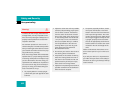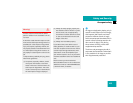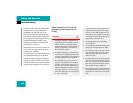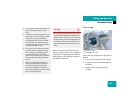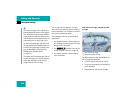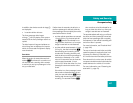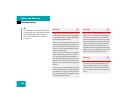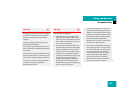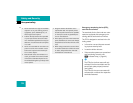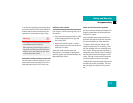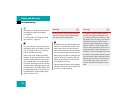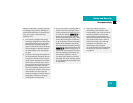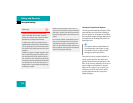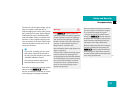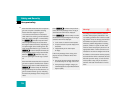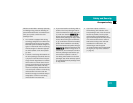
70
Safety and Security
Occupant safety
Emergency tensioning device (ETD),
seat belt force limiter
The seat belts for the front and rear outer
seats are equipped with emergency ten-
sioning devices and belt force limiters.
The ETD is designed to activate in the fol-
lowing cases:
ț in frontal or rear-end impacts exceed-
ing a preset severity level
ț in certain vehicle rollovers
ț if the restraint systems are operational
and functioning correctly, see
1 indicator lamp (
୴ page 60)
ț Never wear belts over rigid or breakable
objects in or on your clothing, such as
eyeglasses, pens, SmartKeys etc., as
these might cause injuries.
ț Position the lap belt as low as possible
on your hips and not across the abdo-
men. If the belt is positioned across your
abdomen, it could cause serious injuries
in a crash.
ț Never use a seat belt for more than one
person at a time. Do not fasten a seat
belt around a person and another per-
son or other objects.
ț Belts should not be worn twisted. In a
crash, you wouldn’t have the full width
of the belt to distribute impact forces.
The twisted belt against your body could
cause injuries.
ț Pregnant women should also use a
lap-shoulder belt. The lap belt portion
should be positioned as low as possible
on the hips to avoid any possible pres-
sure on the abdomen.
ț Never place your feet on the instrument
panel, dashboard, or on the seat. Always
keep both feet on the floor in front of the
seat.
ț When using a seat belt to secure infant
or toddler restraints or children in boost-
er seats, always follow the child seat
manufacturer's instructions.
i
The ETDs for the front seats will only
activate if the front seat belts are fas-
tened (latch plate properly inserted
into buckle).
The ETDs for the rear outer seats will
activate with or without the respective
seat belts fastened.
୴୴



